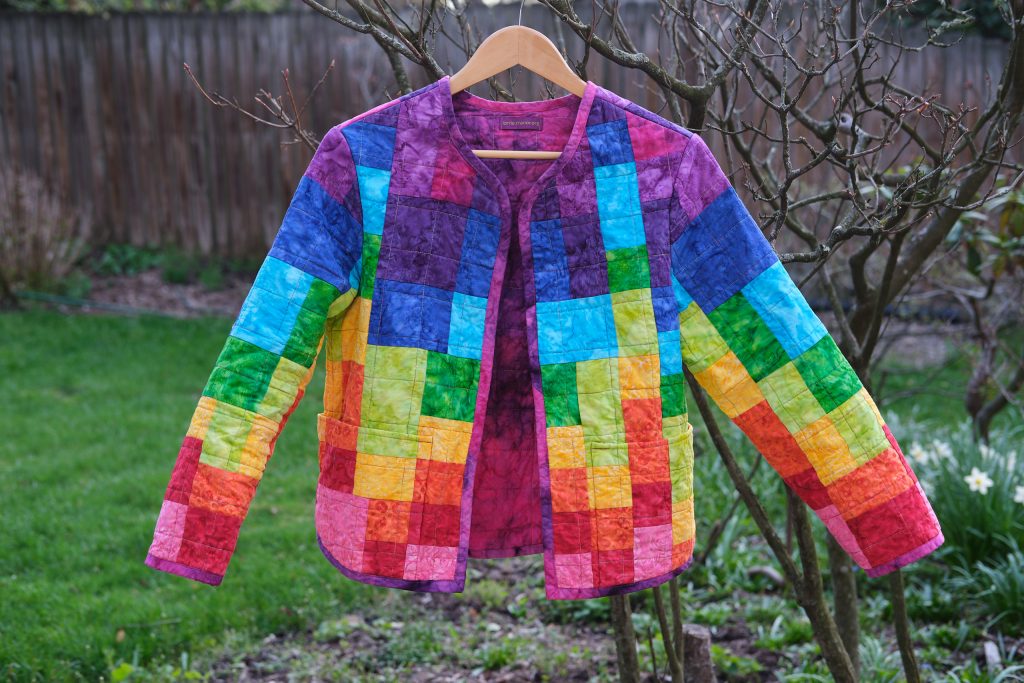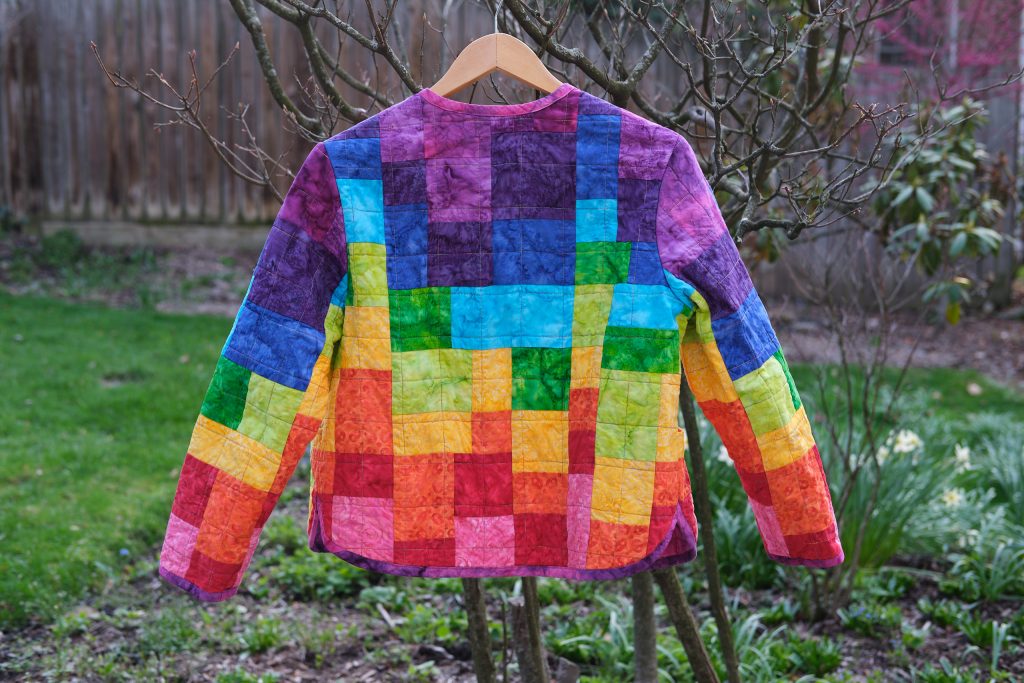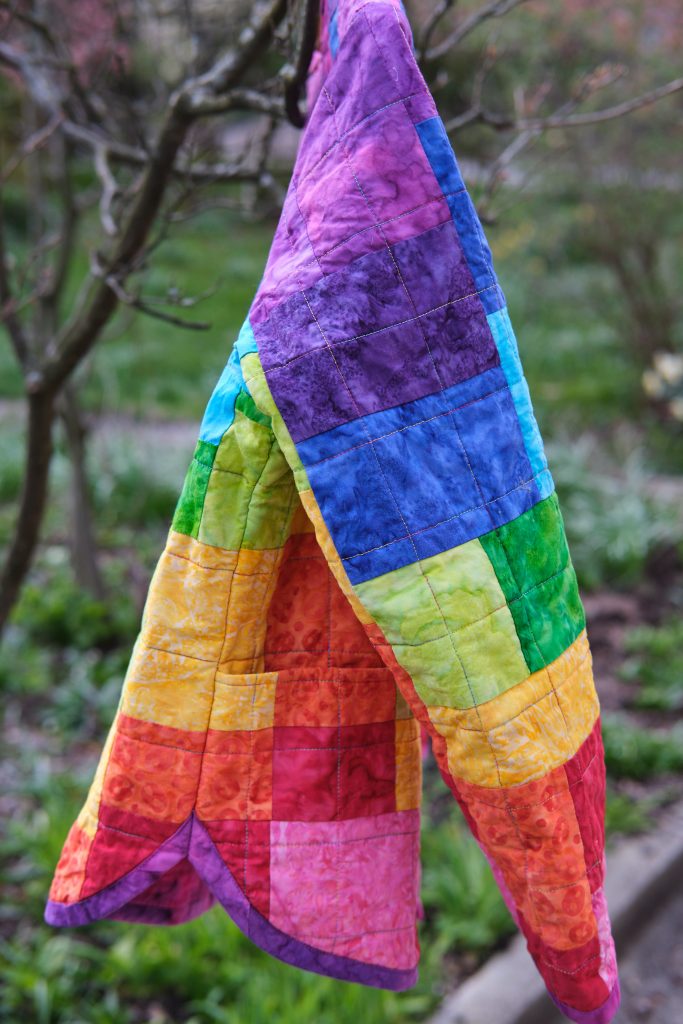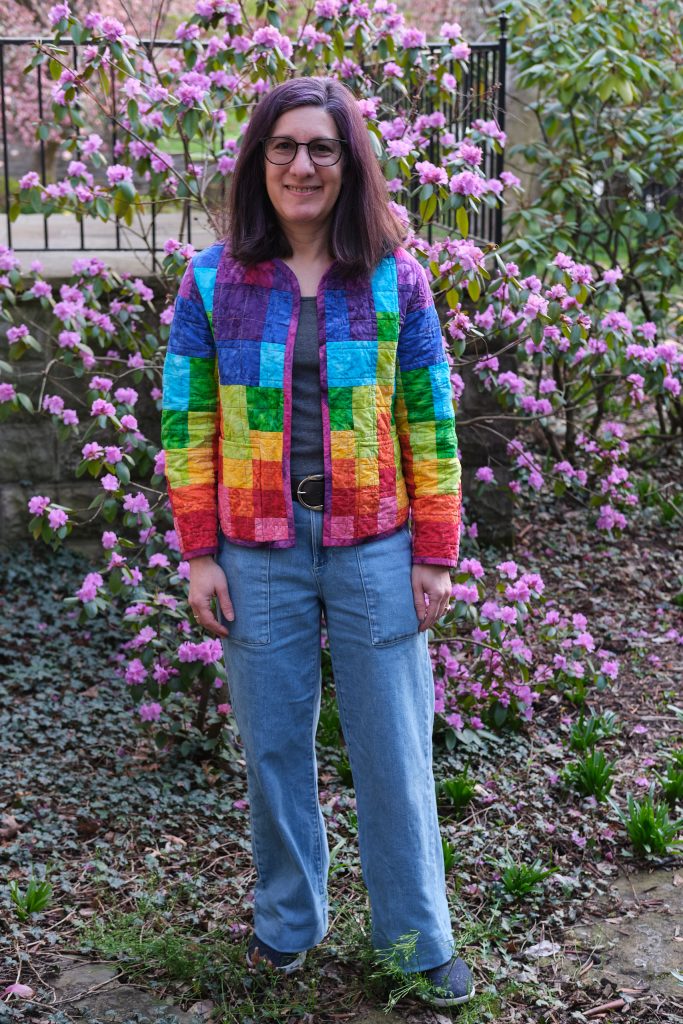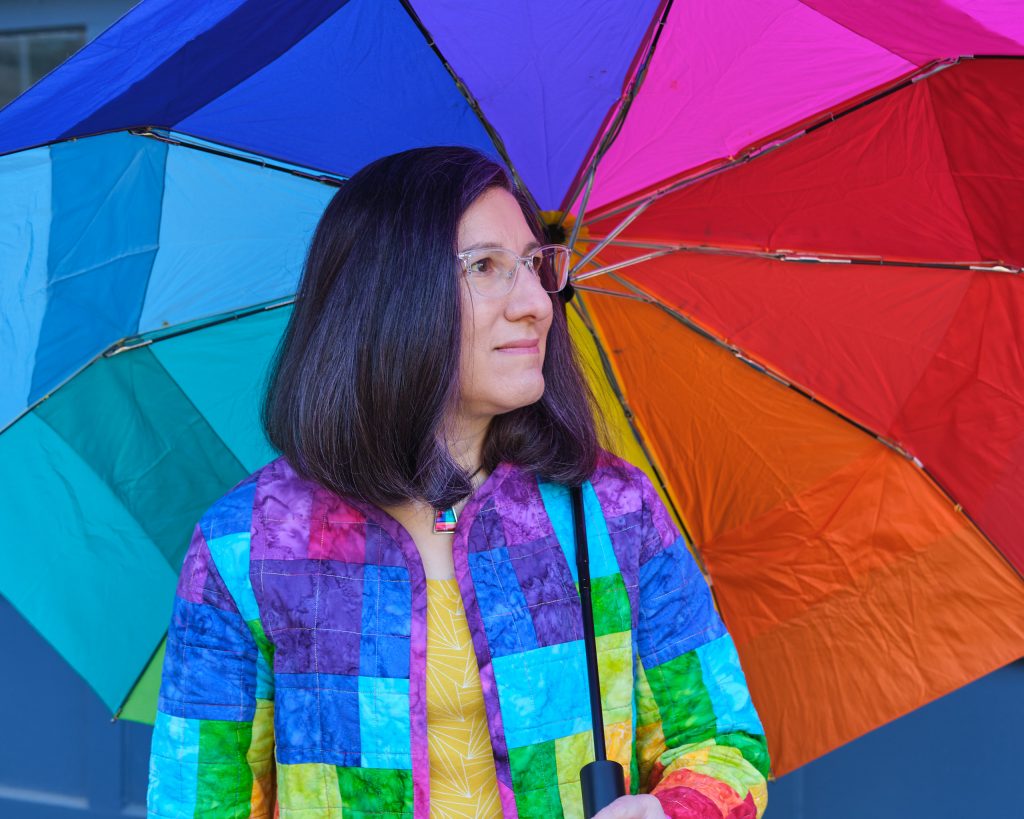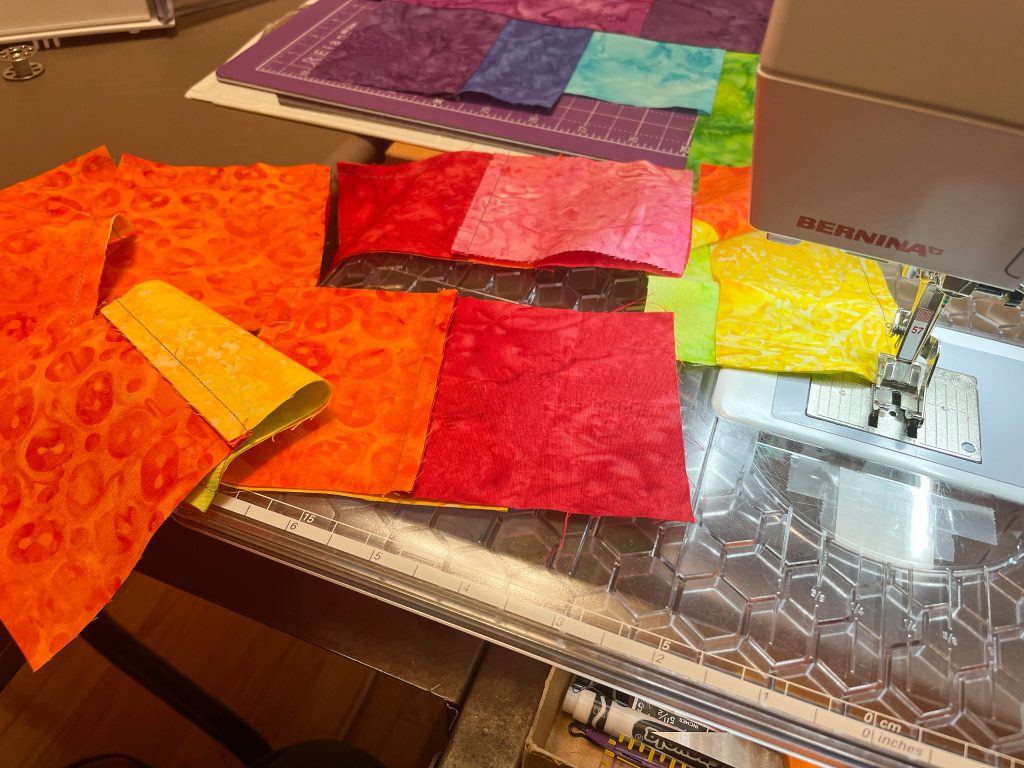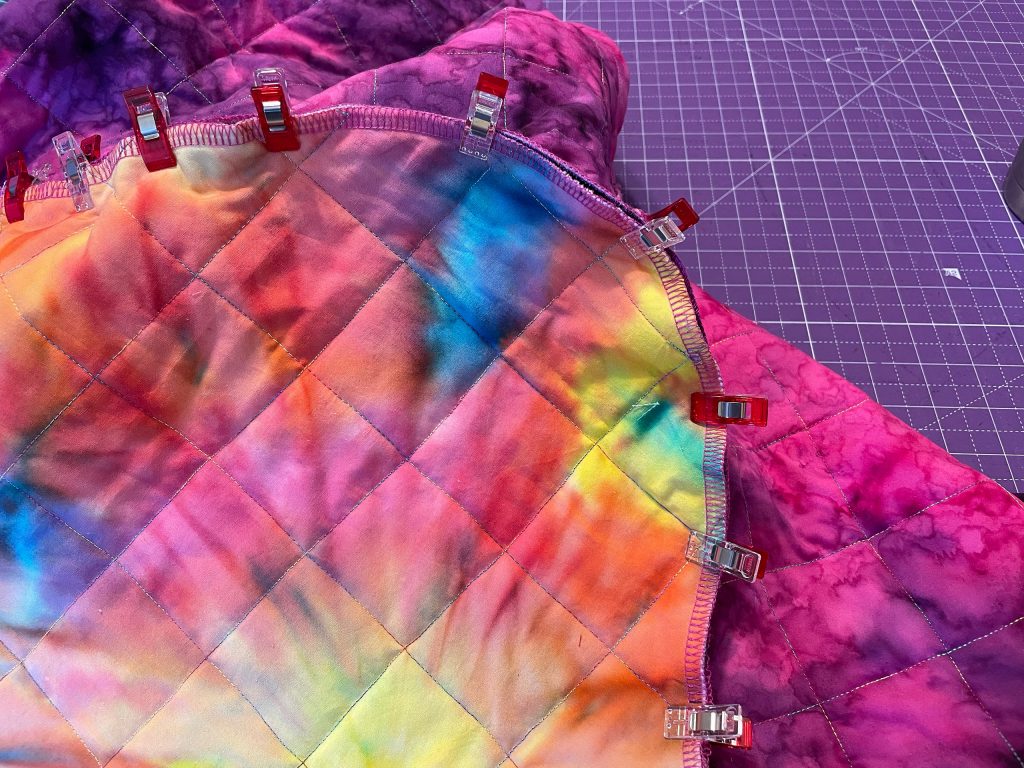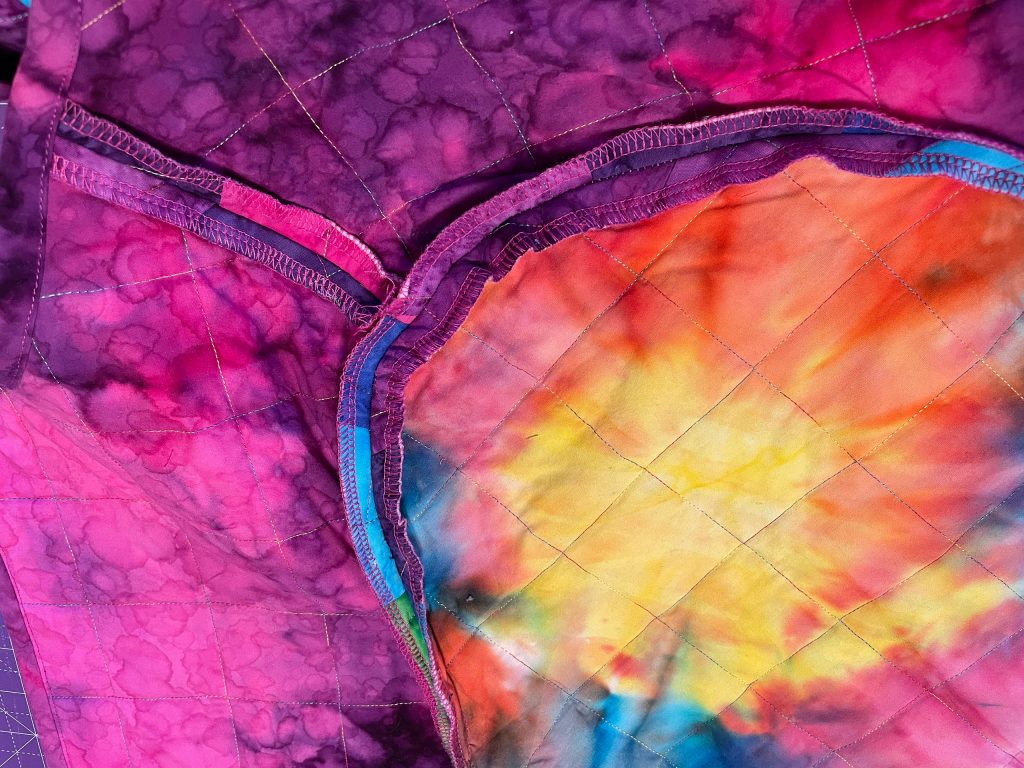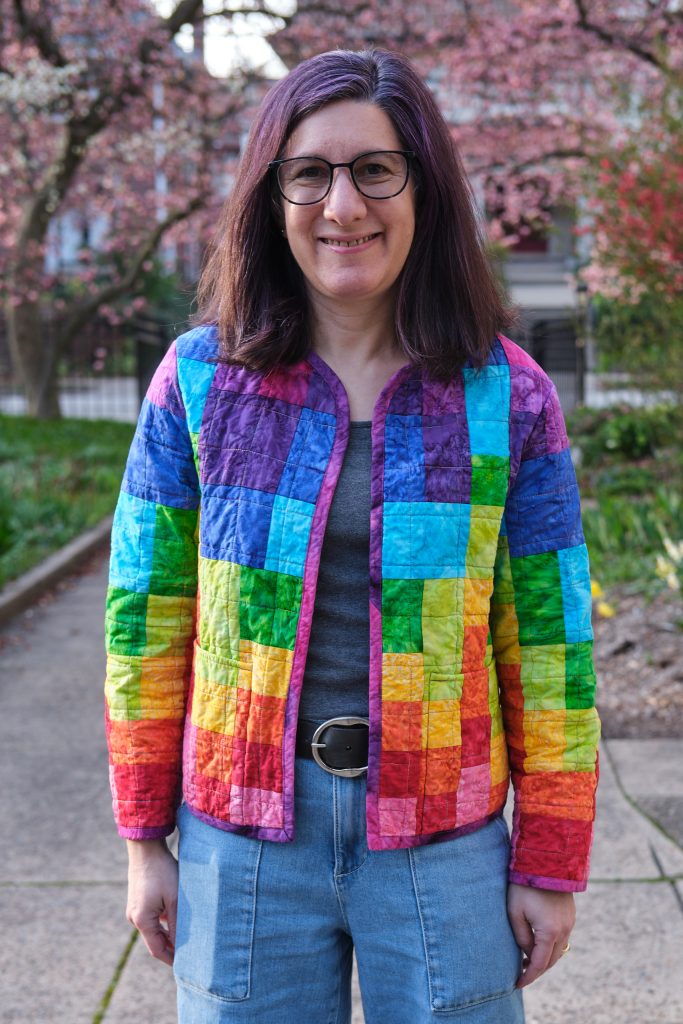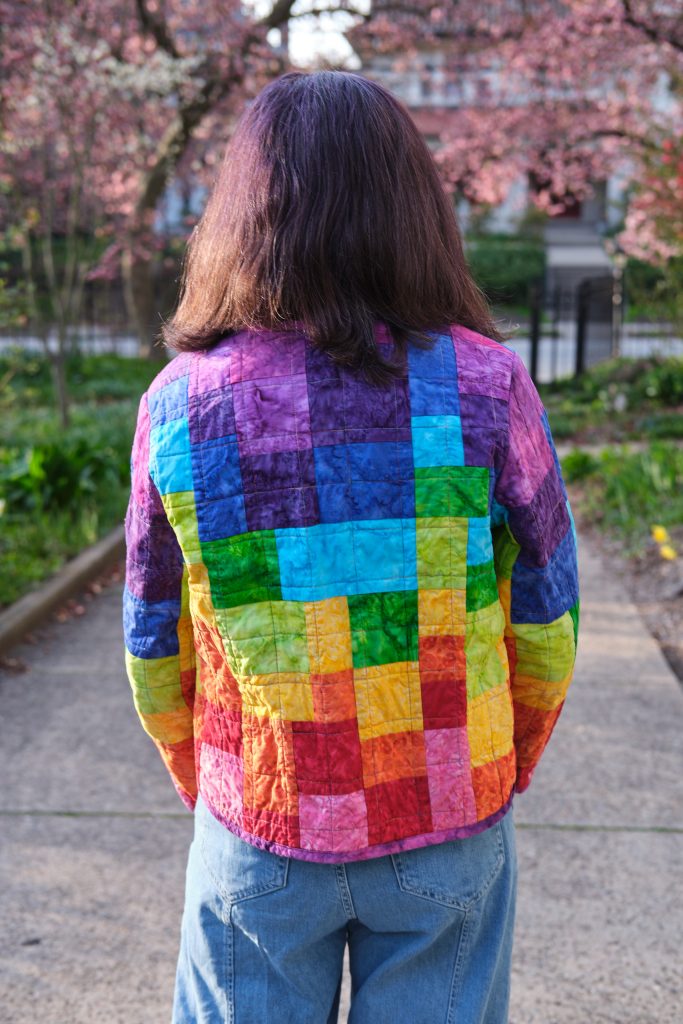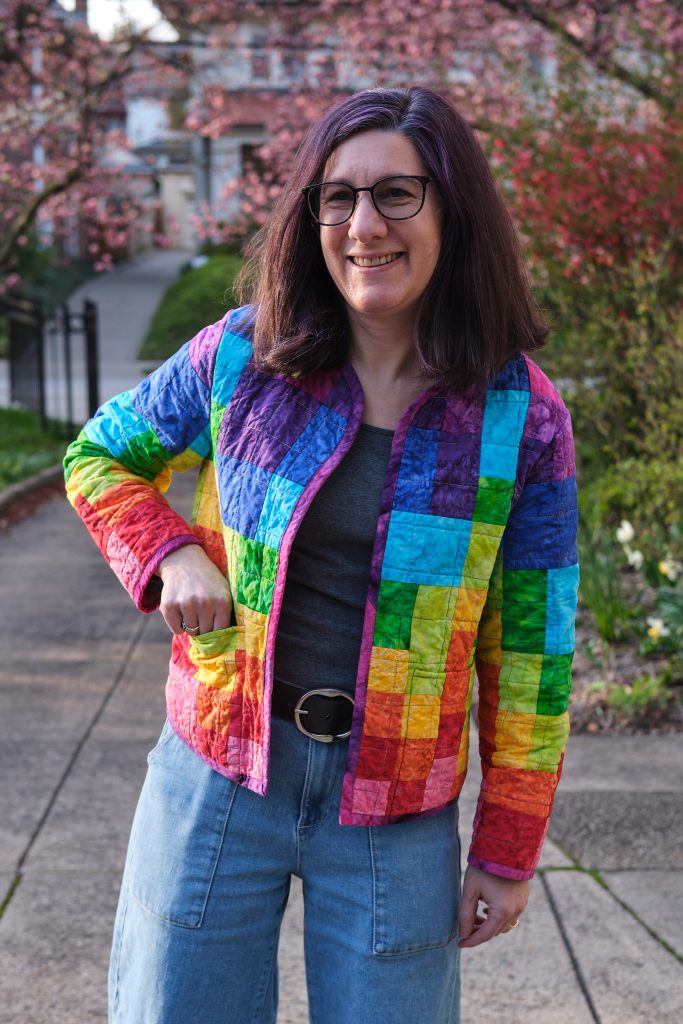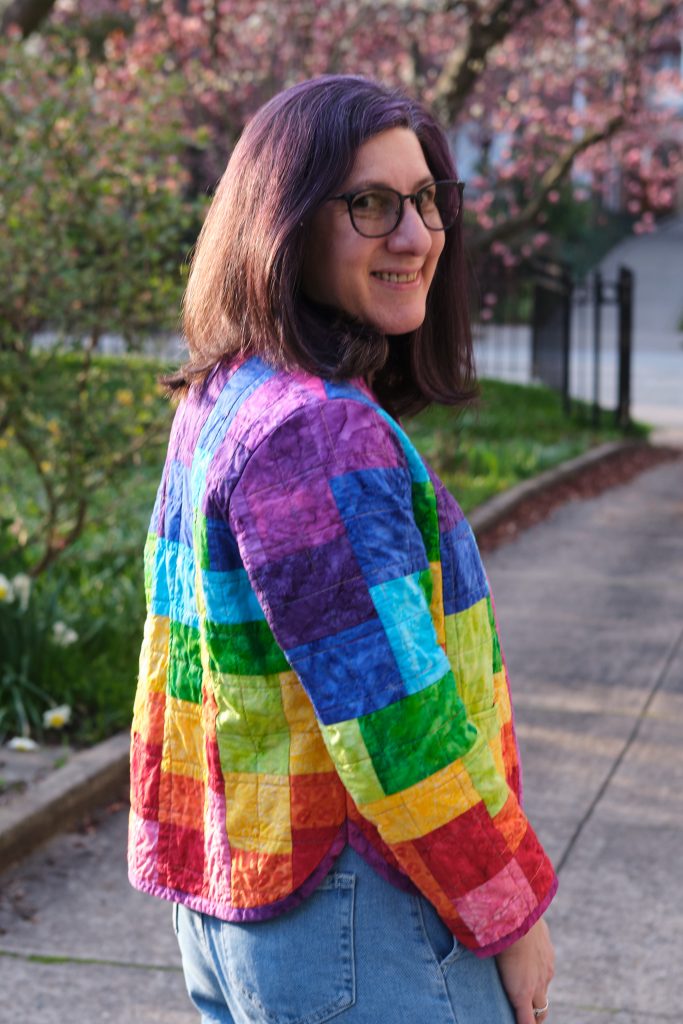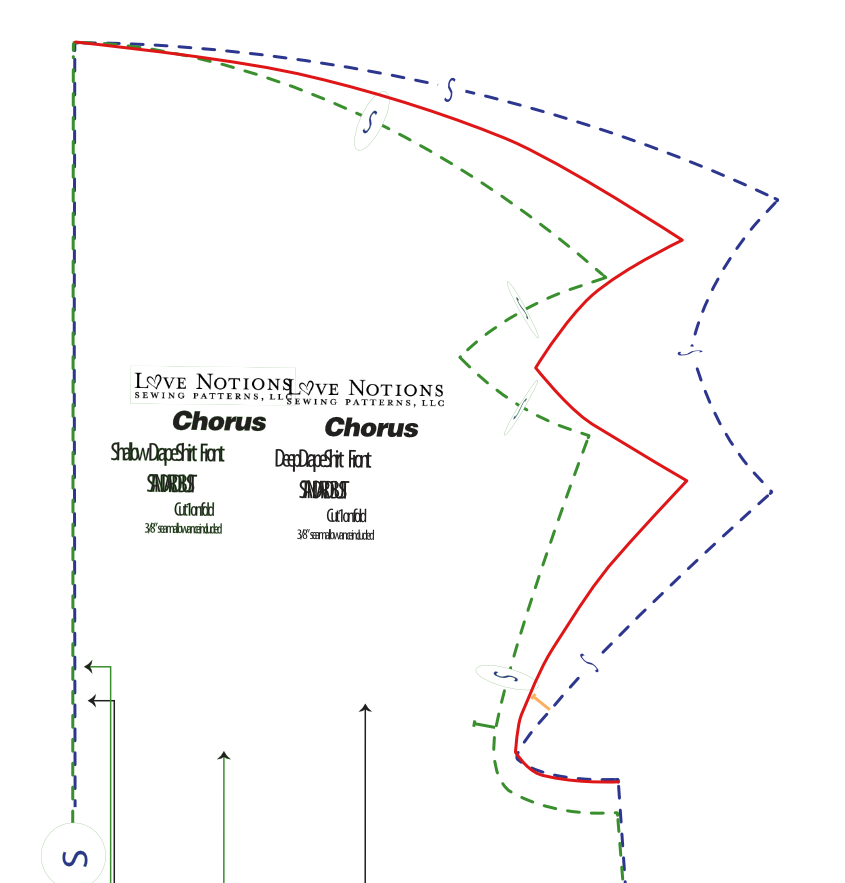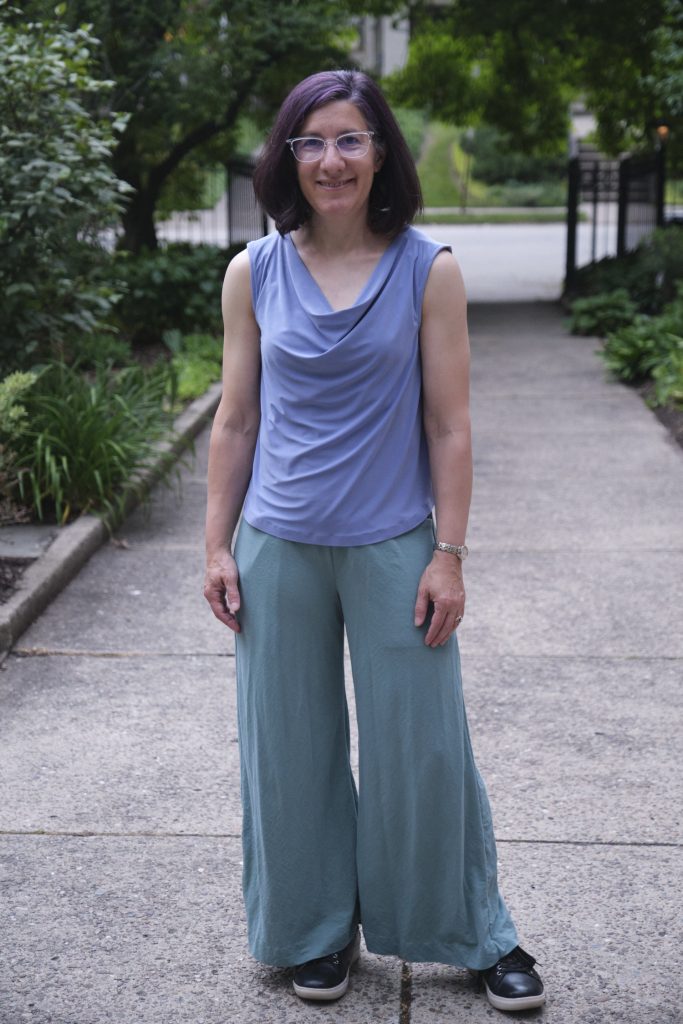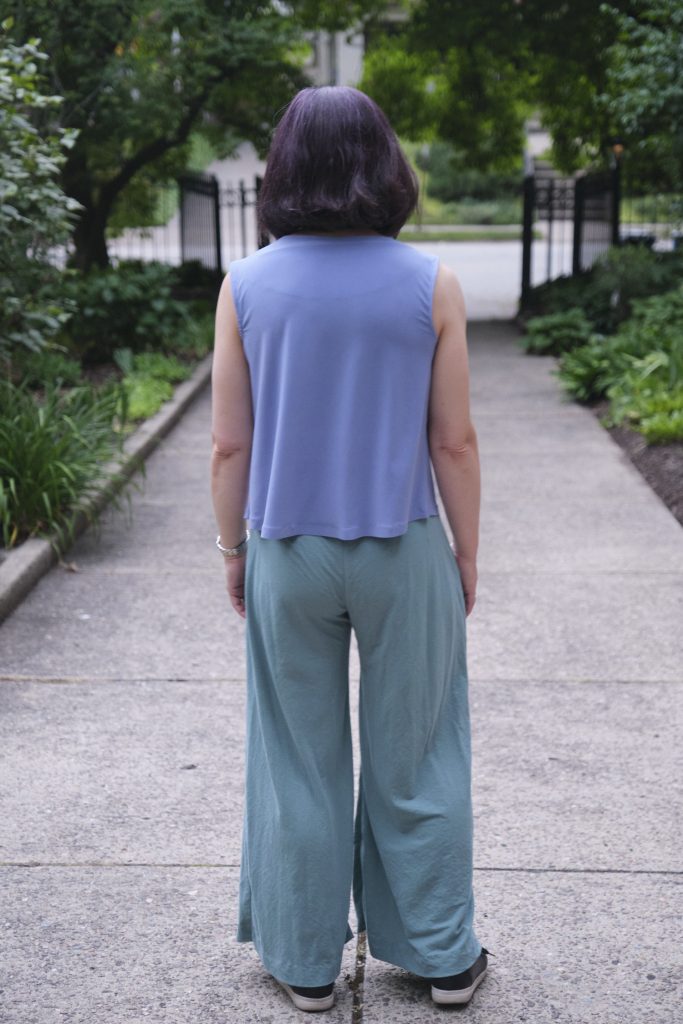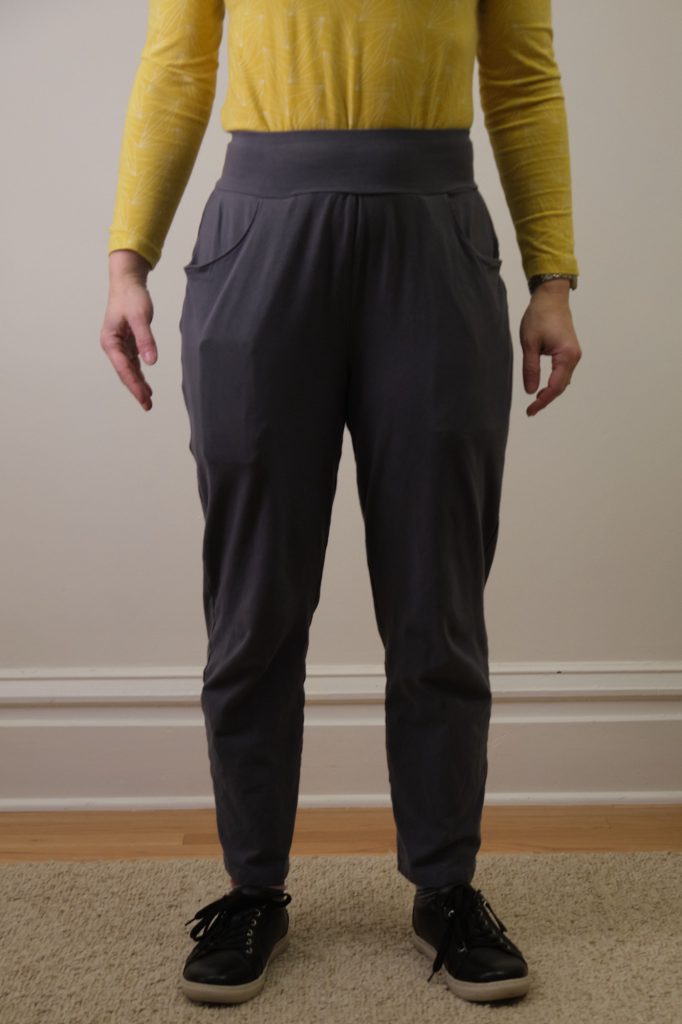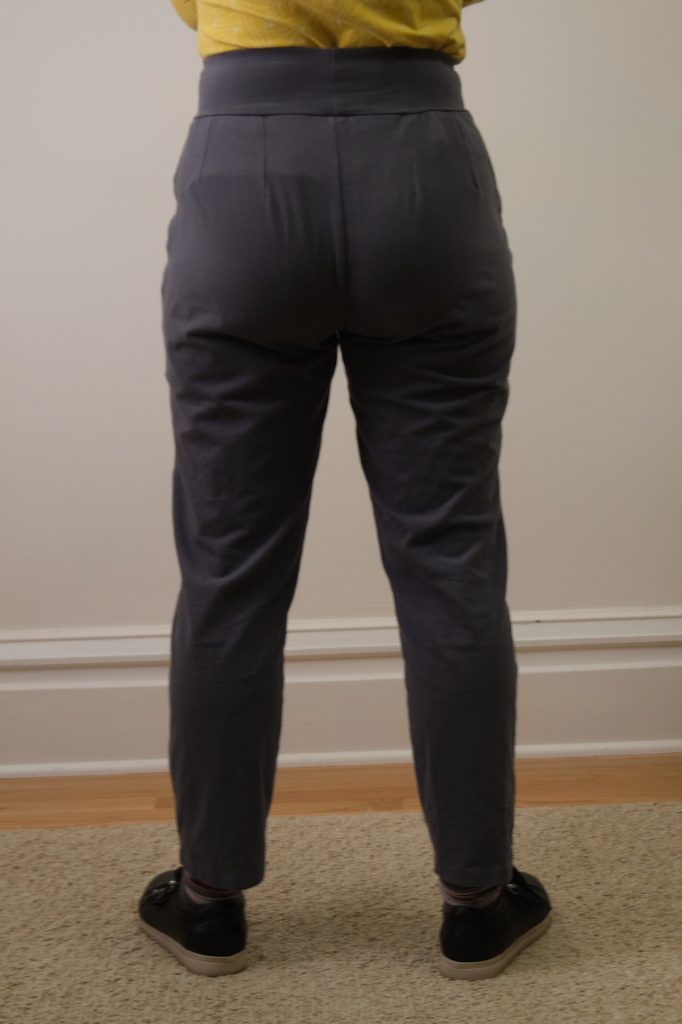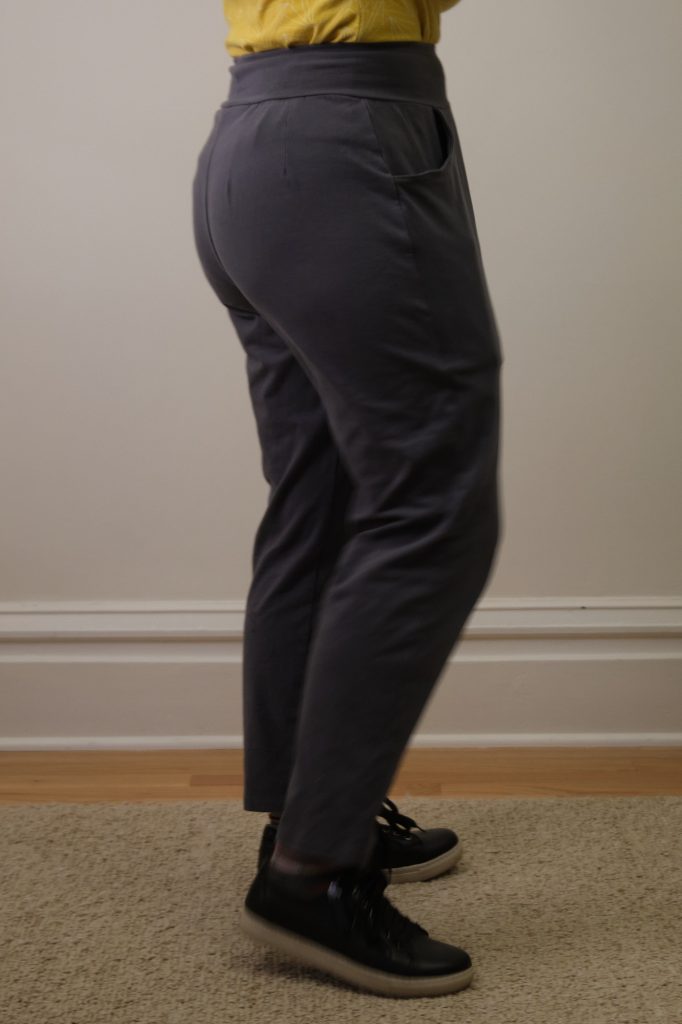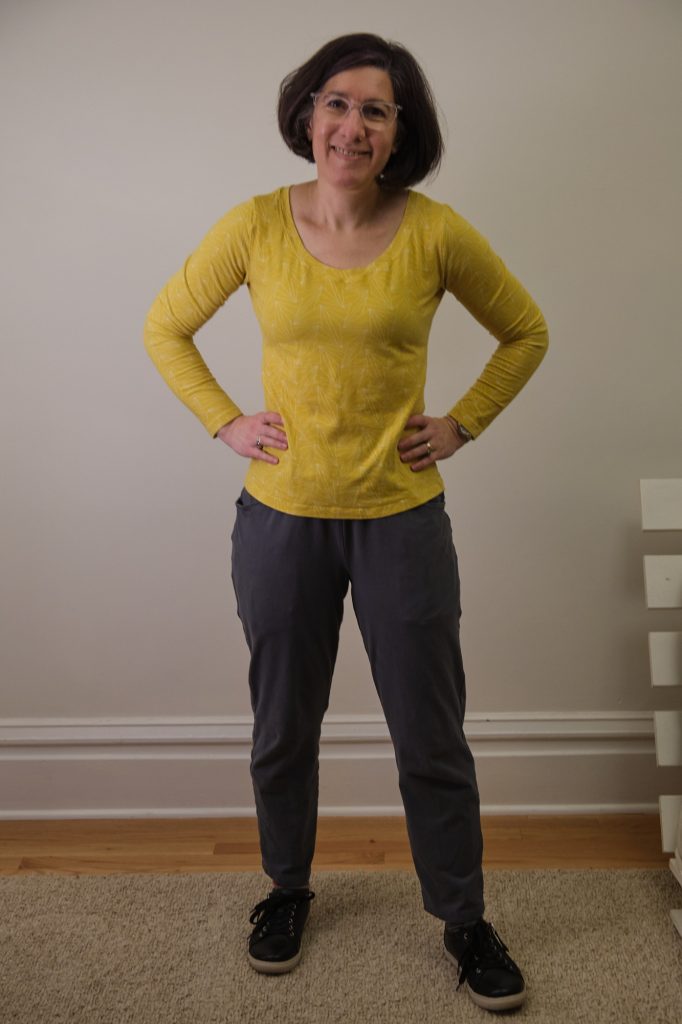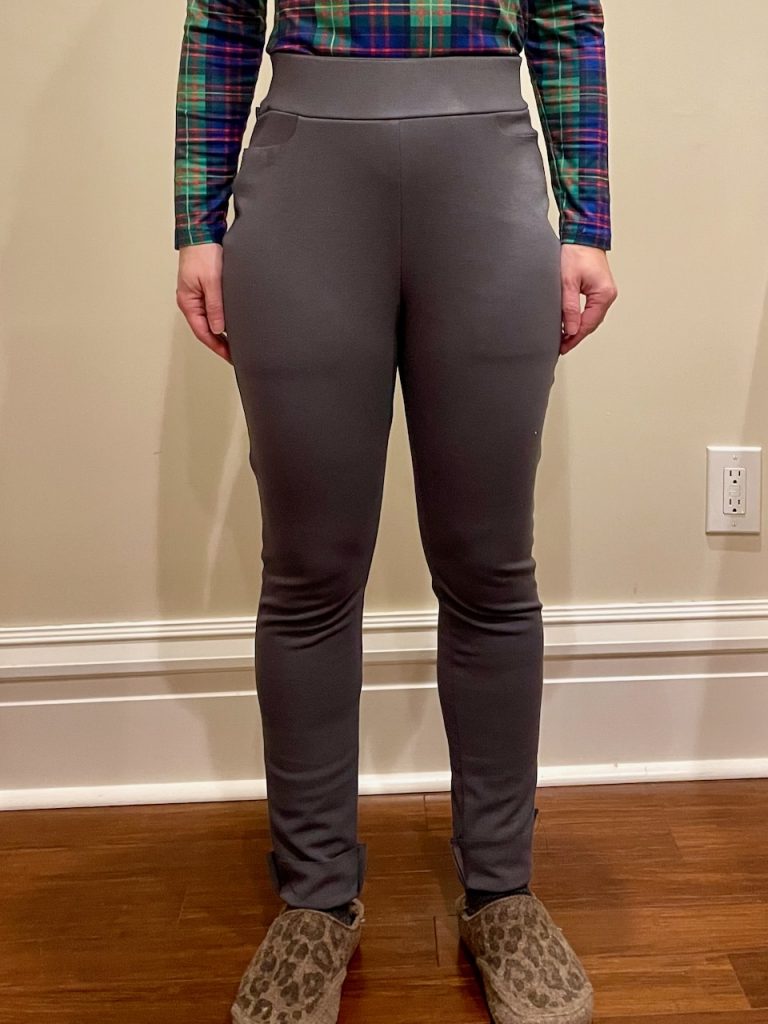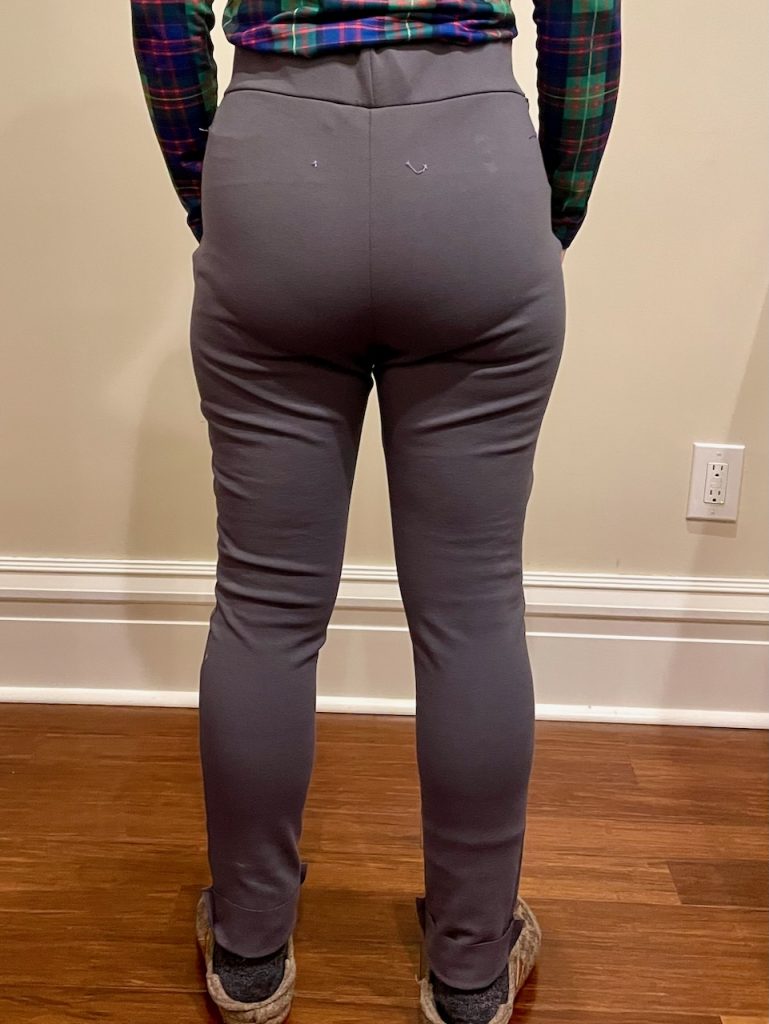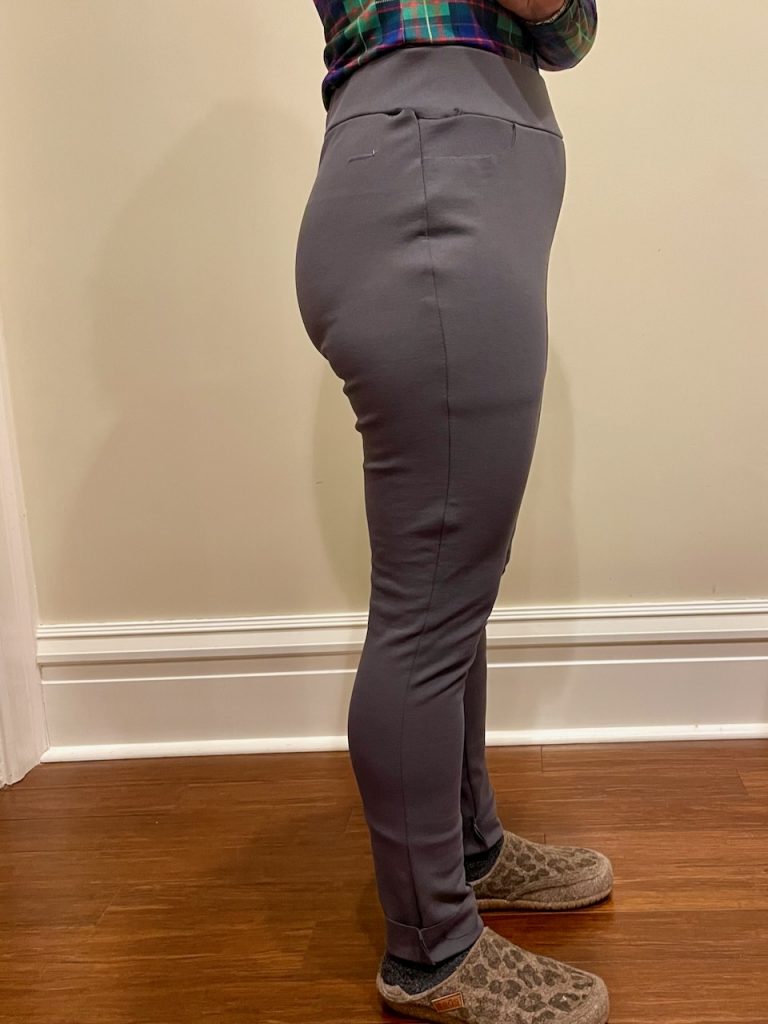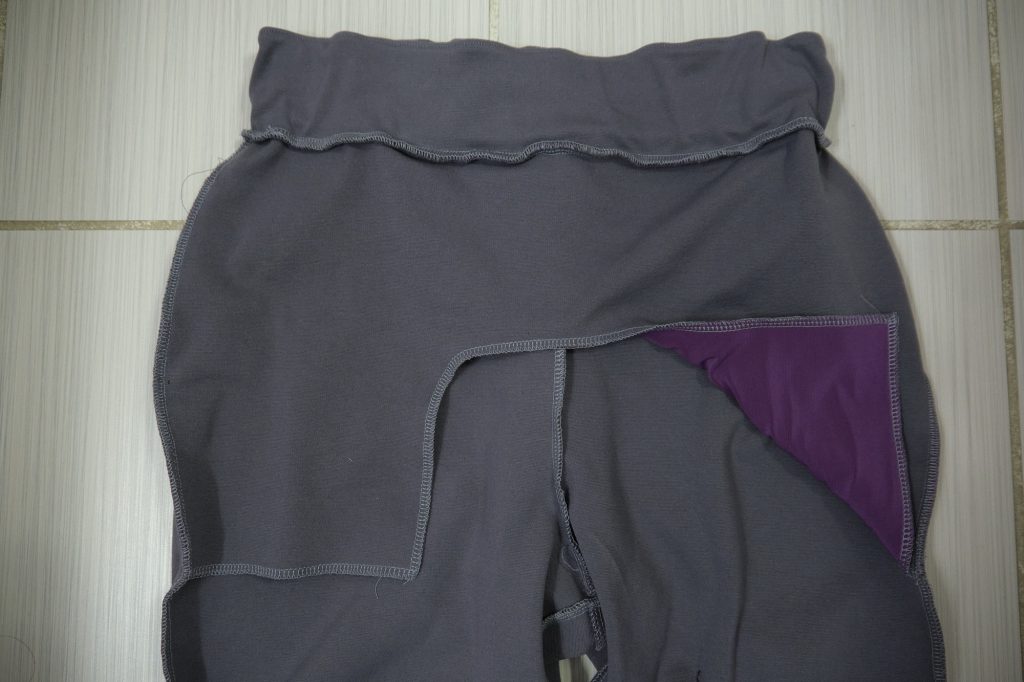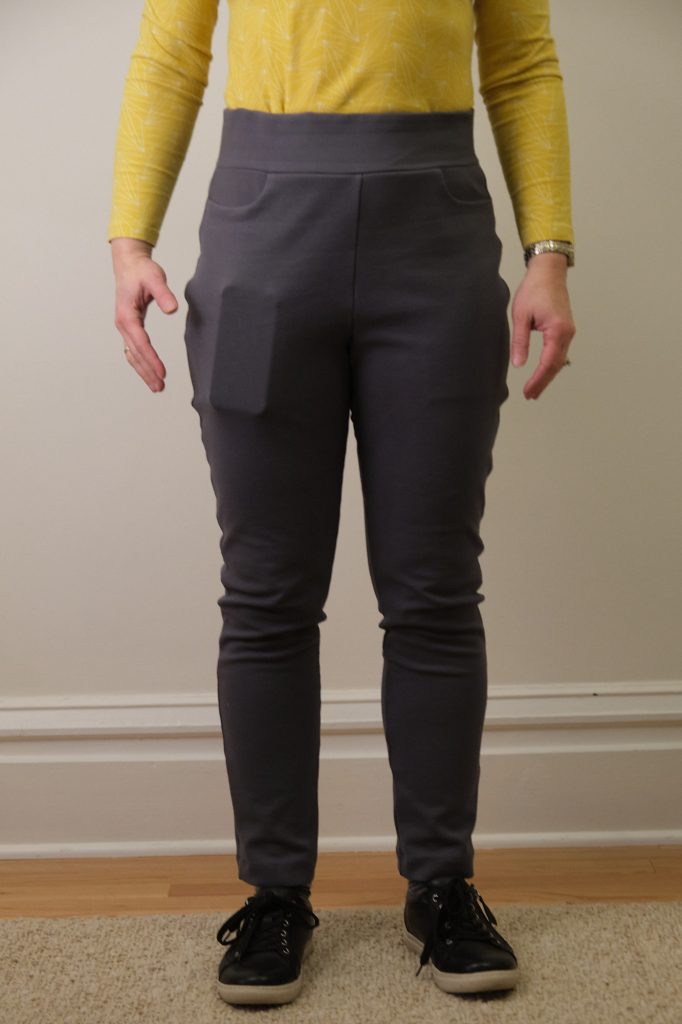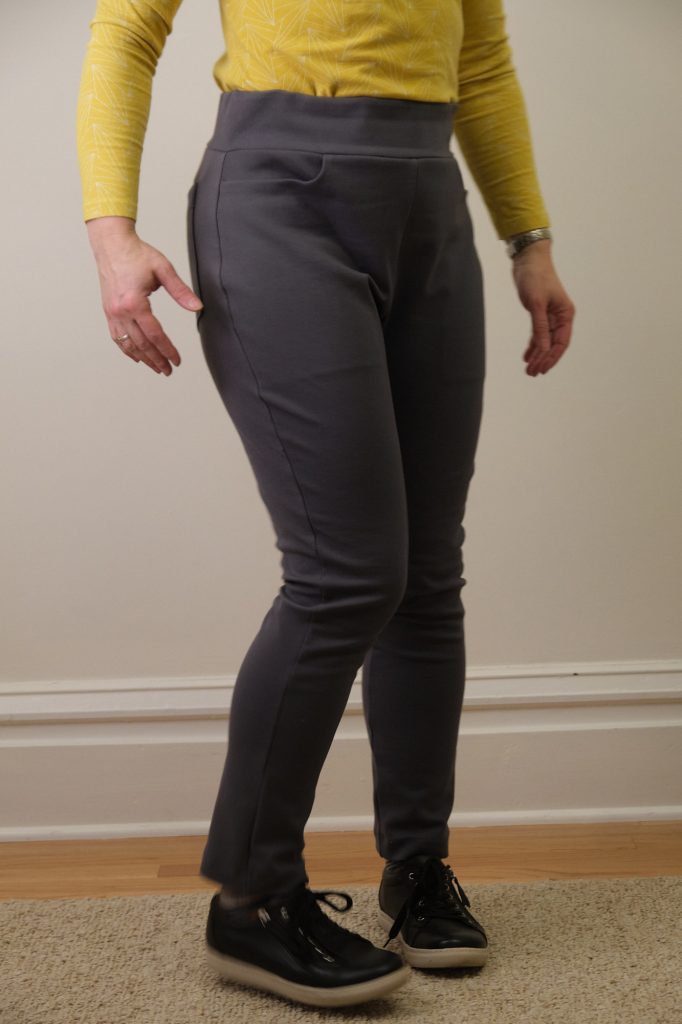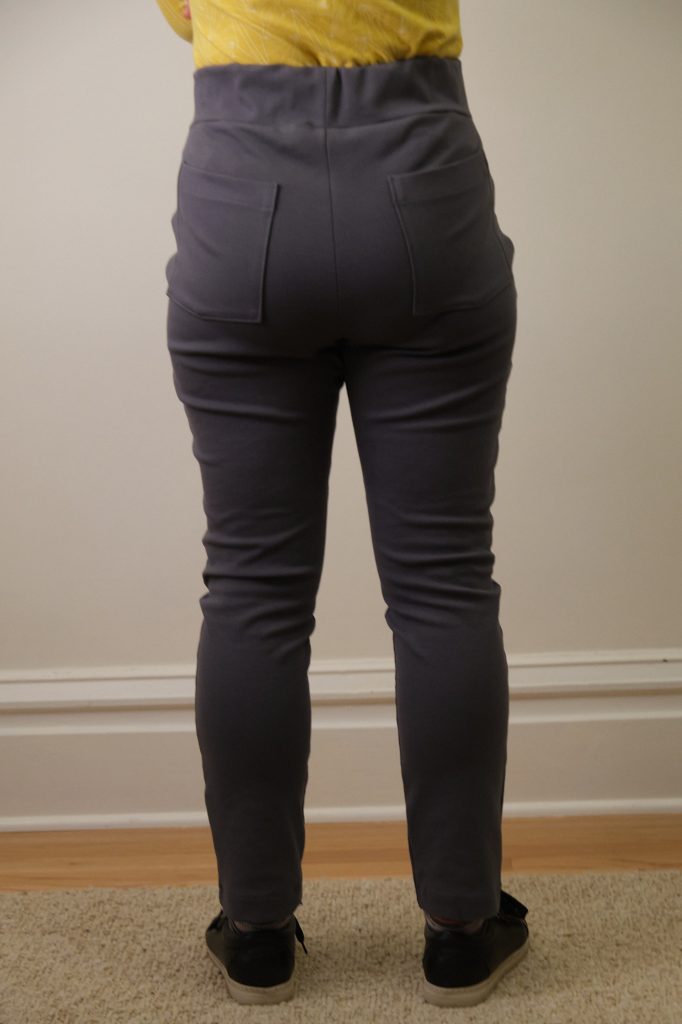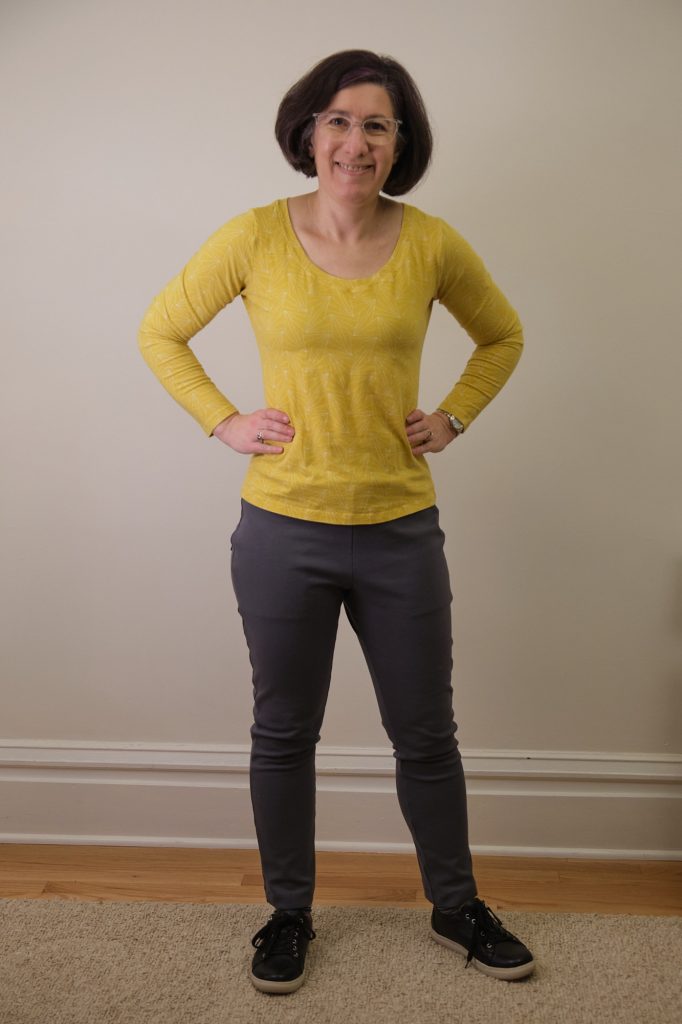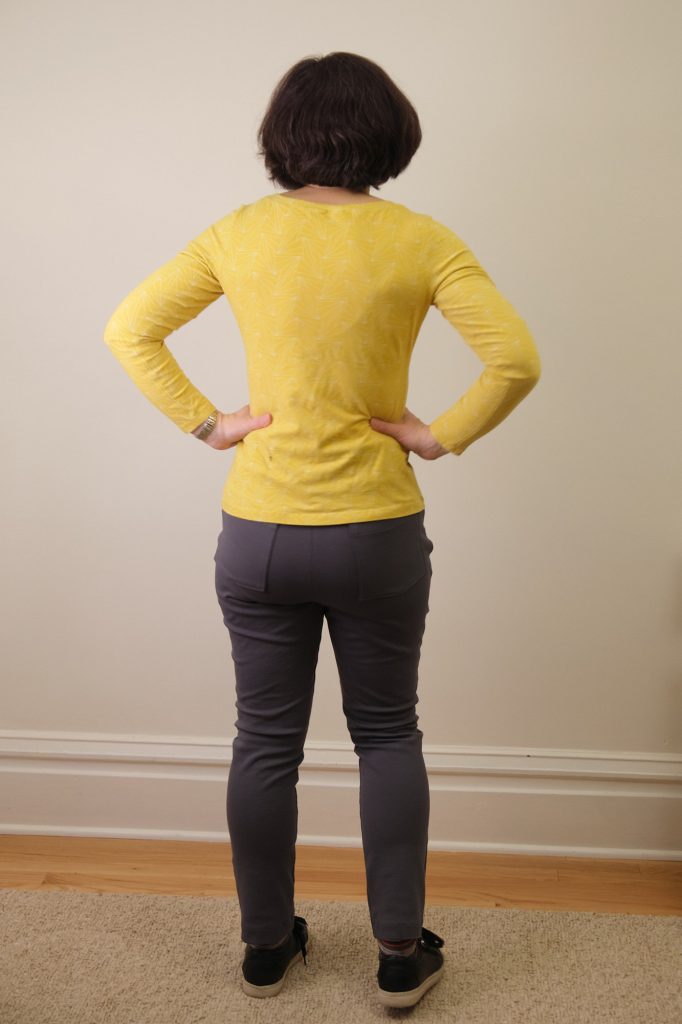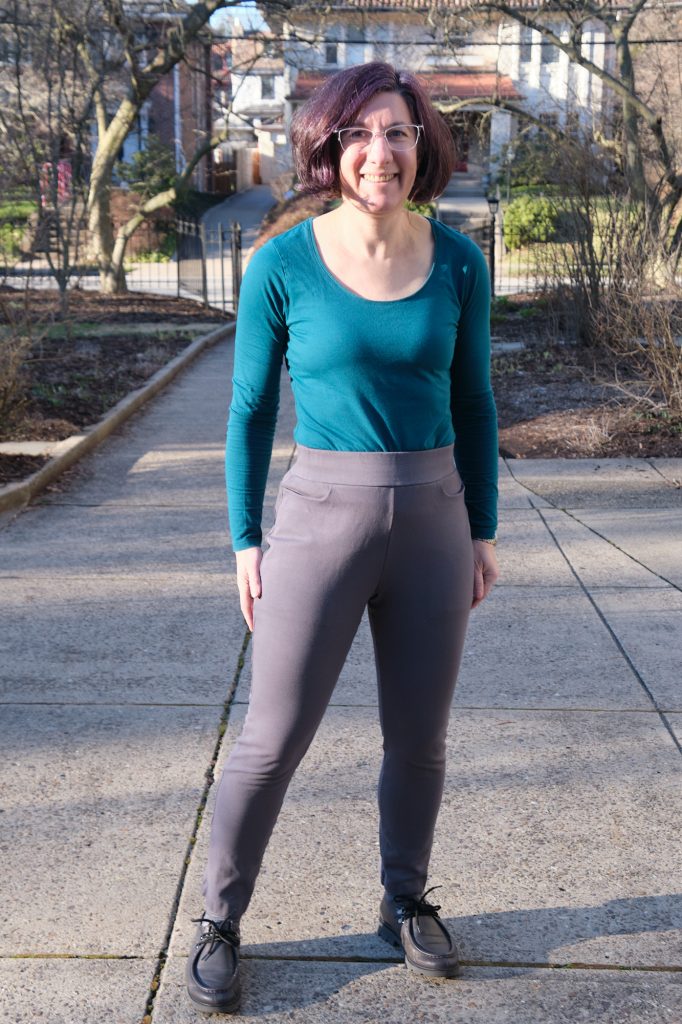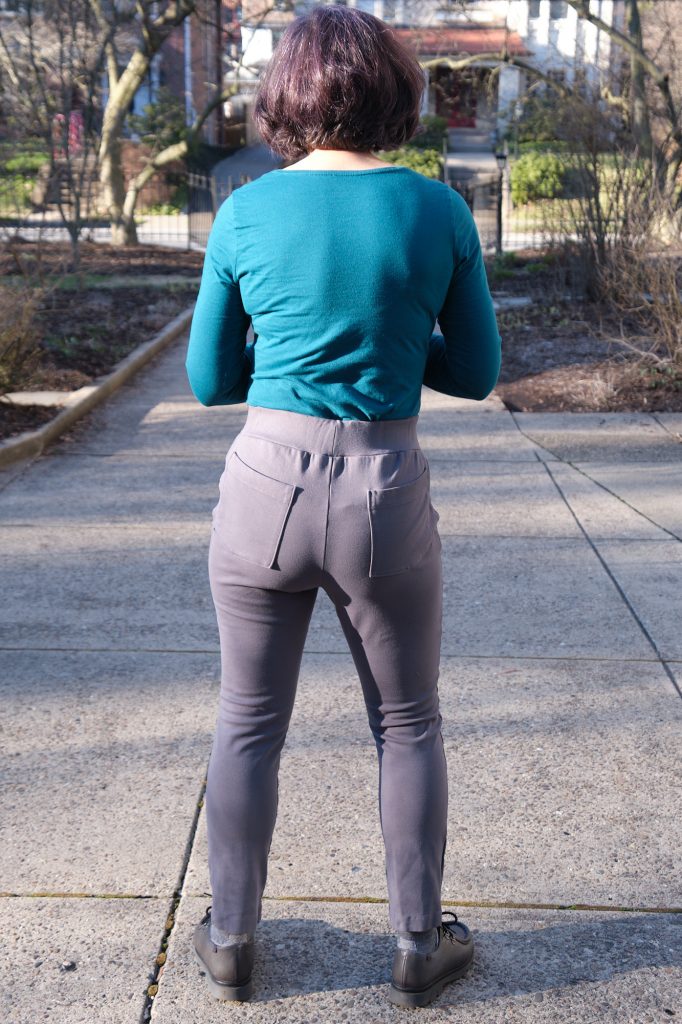It’s been over 20 years since I last sewed a quilted jacket (see my first quilted jacket, made in 1999 and my second, made in 2003). Quilted jackets seem to be somewhat fashionable this year, and when I saw the Love Notions Coda Quilted Coat pattern I had to give it a try. I saw lots of people using pre-quilted fabric or turning thrifted quilts into Coda coats (some nice examples and tips here), but since I am a quilter, I decided to piece and quilt my own Coda (some nice examples and tips here). I spent hours asking the Internet to show me quilted coats, and finally settled on using a rainbow of bright batik fabric from my stash in a random-looking pattern of squares and rectangles that I designed. I was inspired by several of the quilted coats I saw, including Thread + Sprout‘s rainbow scrappy patchy jacket. Here’s my finished coat – yes it is very colorful and bright, but sometimes I need that! Now let me tell you all about how I made it.
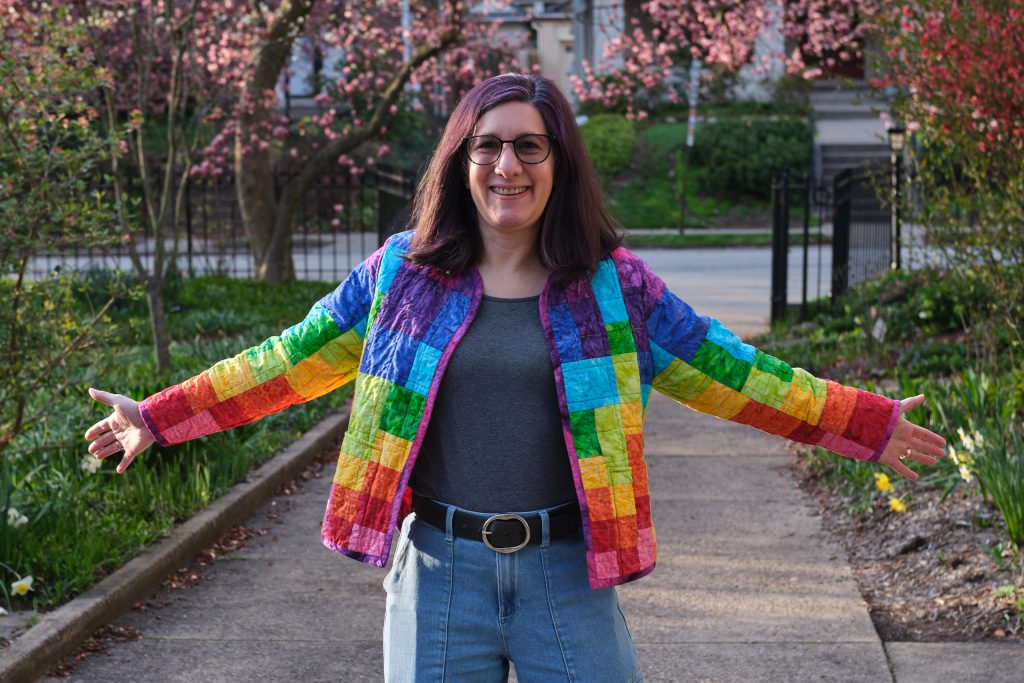
I started with the size small Coda pattern and projected and cut out lining pieces from batik fabric in my stash. I then basted them together to check the fit of the coat. I decided to make a sloped shoulder adjustment, scoop out the back of the neck a bit, and shorten the sleeves by 2.5 inches. I considered shortening the whole coat since I am 5’2″ and it is drafted for someone 5’5″, but I decided I preferred it to be a little longer (and saw that many other sewists were lengthening their Codas). I could have left the sleeves as-is and cuffed them, but figured the quilt would be bulky so decided to shorten so I would not have to cuff.
Next I needed to decide what type of batting to use. I usually use cotton or fusible polyester cotton batting, but was hoping to make a lighter-weight jacket so looked to see what batting people recommended. I noticed that people who wanted a lighter batting often chose silk or bamboo. I ordered both from Battingsupersale.com (first time ordering from them and was quite pleased) and chose their Simply Bamboo batting because it seemed softer and drapier than the silk.
Next I designed my quilt. I drew out my pattern in Affinity Designer and overlayed it on the Coda pattern pieces. Then I started cutting up my fabric and made a stack of the squares and rectangles needed for each section of the jacket. One piece at a time I laid out each section (guided by a print-out of the design), and pieced it with my quarter-inch guide foot. I pressed the seam allowances in opposite directions so they would butt up to each other nicely, and occasionally applied a dab from my fabric glue pen to achieve perfect alignment.
Once I pieced all the sections, it was time to make the quilt sandwiches. I spread out my bamboo batting on the floor and attached the lining pieces with basting spray, which is basically a light-weight repositionable glue (like on a post-it note). This is the first time I used basting spray, and it was a lot easier than I anticipated. It mostly stayed where I sprayed it and did not have a lot of lingering fumes. I then used the lining pieces as templates to cut out the batting. Then I layered the batting/lining pieces on top of my pieced sections, carefully aligned them, and cut them out. I had designed the pattern so that the front and back pieces all aligned so it was important to get everything lined up properly. I did not use spray baste here because I discovered that the bamboo batting was very clingy and stayed in place just fine on its own without any pins or glue.
Now it was time to quilt. After weighing many quilting options, I decided to go for a simple two-inch grid, quilted with a variegated rainbow polyester thread (with the same thread in the bobbin). I used a hera marker and a ruler to mark the quilt lines, and I quilted it using my walking foot. It mostly went well, but I’ve been having some issues with the bobbin tension on my sewing machine and the stitches are not as even as I would have liked.
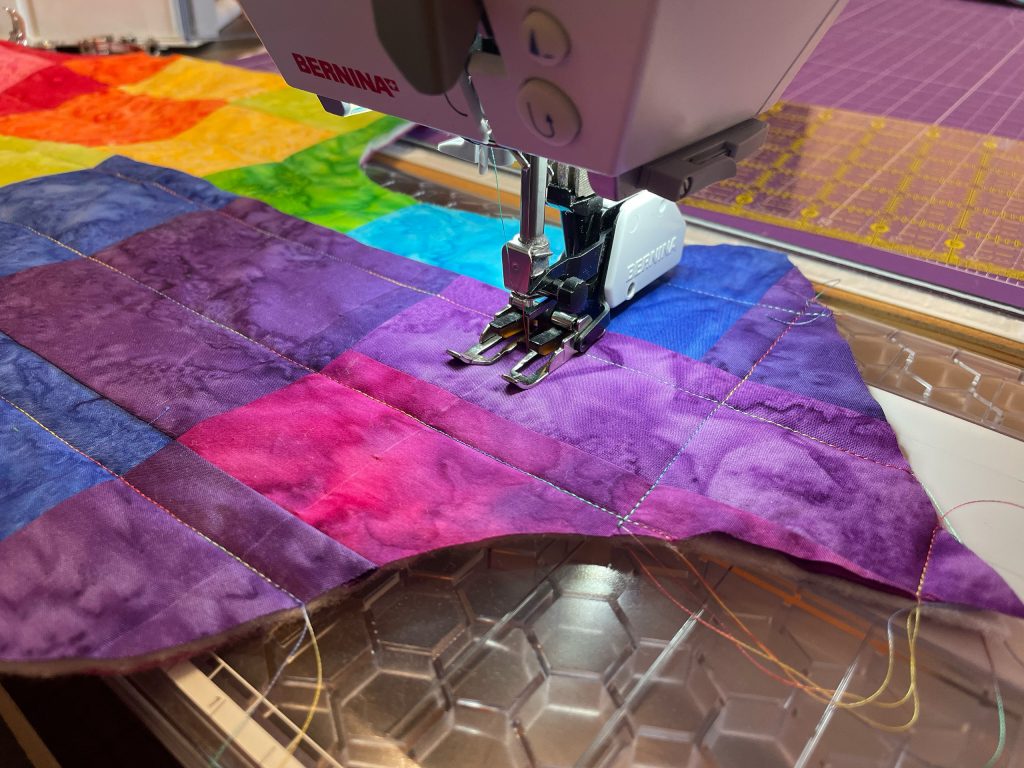
After all the pieces were quilted I lined up and carefully attached the pockets. I decided not to bind the tops of the pockets and just folded them under and topstitched. Without binding, they are almost invisible since I matched the pattern and the quilting pretty well. Then I surged around all the edges with pink thread that sort of matched most of the lining.
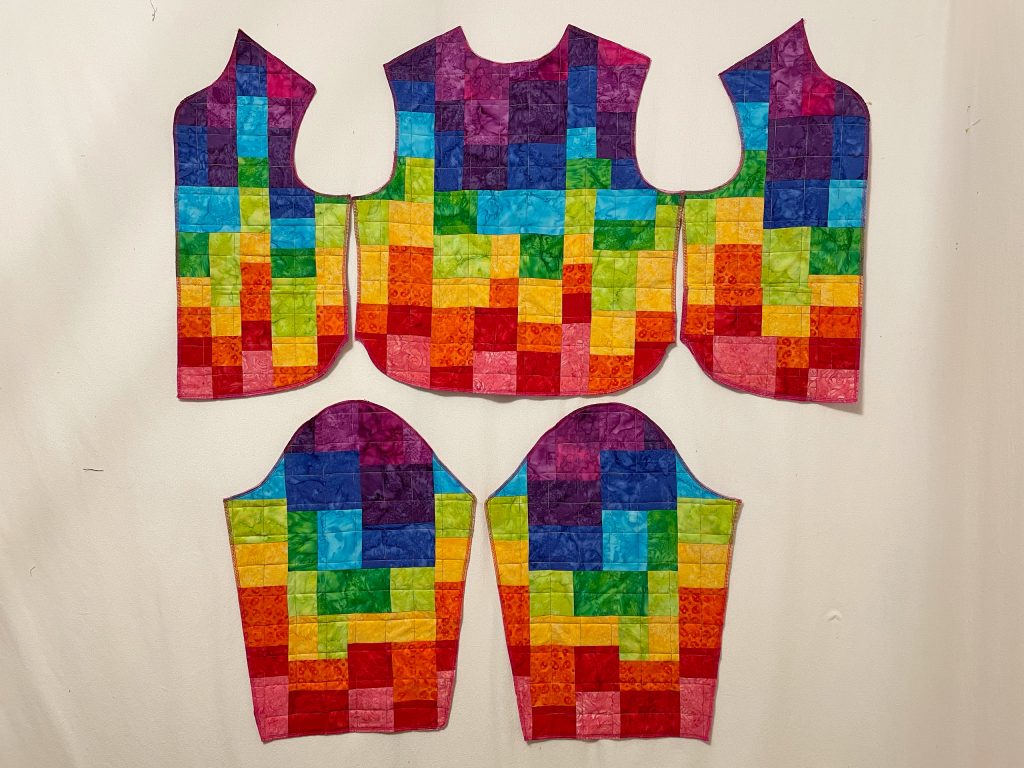
I had previously considered my construction options. Should I quilt the lining with the top and batting or use a separate lining piece? I decided to quilt the lining because I thought it would further minimize bulk. I think its fine, but you do end up with interior seams that you have to treat. I decided to serge the edges, sew with a half-inch seam allowance, and press open. A nicer option would be to bind them, but I didn’t want to bother. Next time (yes there will be more quilted coats) I may just add a separate lining and keep all those pesky seams hidden from view, as some sewists suggest (this tutorial has lots of great tips).
I ended up sewing the shoulder seams and attaching the sleeves, but leaving the side seams unsewn until after I attached the binding so as to avoid having to bind the sharp corner where the front and the back meet.
The pattern suggests making your own double-fold bias binding tape, something I had never done (I usually bind with French-fold binding, as is common for quilts). But I read that making double-fold bias binding tape was pretty easy to do, especially with the help of a cheap bias tape tool. Some sewists even find making binding tape quite enjoyable. Having now tried it, they are not wrong. I used this nifty technique where you start with a large square, cut it into two triangles, mark them lines parallel to the hypotenuse, and sew them together in a staggered way so that you can use your scissors to cut one long continuous bias trip. Then you run it through your bias tape tool and iron and you have binding. I followed this process with 2-inch strips to make half-inch bias binding. It worked great except that I miscalculated and started with a 15-inch square, and ended up with slightly less binding than I actually needed, so I had to stop attaching the binding and go make some more. Next time I’ll probably go with an 18-inch or 20-inch square to make sure I have more than enough.
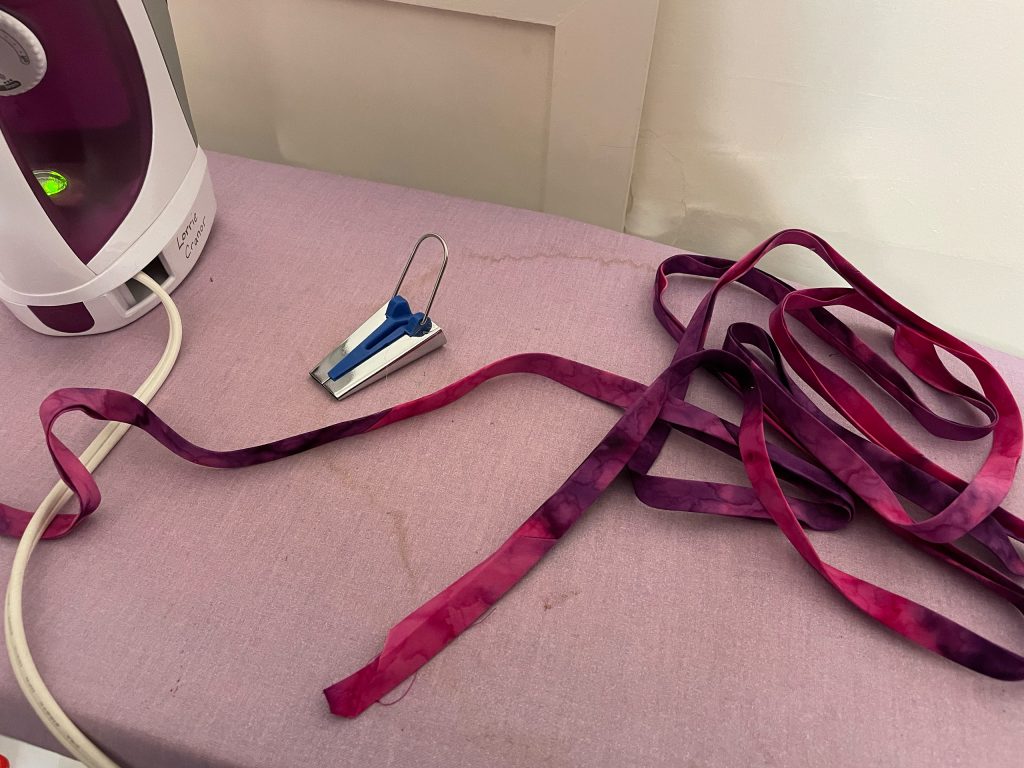
Once I made the binding, I followed the pattern instructions to attach it to the jacket by first unfolding it and sewing it to the inside, then wrapping it around to the front and sewing it in place. Instead of pinning it to the front I held it in place with a thin bead of Elmer’s washable school glue, and then set it with my iron (you can still easily peel it off, even after ironing). Yes, I have really embraced the use of adhesives in sewing – for this project I used basting spray, fabric glue pen, and Elmer’s glue. Once the binding was in place, I stitched it near the edge, sewed up the side seams, added a label, and I was done.
I tried it on and was fairly pleased with the results, but despite my use of bamboo batting, it was still pretty stiff. I decided it needed to go through a round of washing and drying to loosen it up a bit, shrink it slightly, and turn it into its natural puckered shape. If you never wash a quilt you can keep it nice and crisp, but I plan to wear this one enough that it will need to be washed, so I figured I might as well get that over with now and soften it up in the process. I always have a little bit of fear about washing a quilt though. I tossed it in my washer on delicate cycle with Woolite, and then after a quick spin in the dryer it was ready to wear (and much more comfortable now).
This project took a bit longer than most of the clothes I make because first I had to make a quilt and then turn it into a jacket. It would be much faster with pre-quilted fabric or cutting up an old quilt. But I really enjoyed both the process and the very colorful results!
